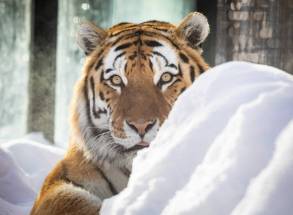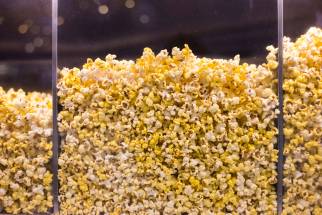Playful predators With the Year of the Tiger upon us, meet the zoo’s Amur tigers, Yuri and Volga
Read this article for free:
or
Already have an account? Log in here »
To continue reading, please subscribe:
Monthly Digital Subscription
$0 for the first 4 weeks*
- Enjoy unlimited reading on winnipegfreepress.com
- Read the E-Edition, our digital replica newspaper
- Access News Break, our award-winning app
- Play interactive puzzles
*No charge for 4 weeks then price increases to the regular rate of $19.00 plus GST every four weeks. Offer available to new and qualified returning subscribers only. Cancel any time.
Monthly Digital Subscription
$4.75/week*
- Enjoy unlimited reading on winnipegfreepress.com
- Read the E-Edition, our digital replica newspaper
- Access News Break, our award-winning app
- Play interactive puzzles
*Billed as $19 plus GST every four weeks. Cancel any time.
To continue reading, please subscribe:
Add Free Press access to your Brandon Sun subscription for only an additional
$1 for the first 4 weeks*
*Your next subscription payment will increase by $1.00 and you will be charged $16.99 plus GST for four weeks. After four weeks, your payment will increase to $23.99 plus GST every four weeks.
Read unlimited articles for free today:
or
Already have an account? Log in here »
Hey there, time traveller!
This article was published 31/01/2022 (1409 days ago), so information in it may no longer be current.
Fran Donnelly’s coworkers Yuri and Volga are much bigger than she is. They can jump 15 feet in the air and can swim up to 25 kilometres per hour. They weigh a combined 300 kilograms. They wear a permanent coat of coarse orange and white fur, with black stripes. Their ancestors come from Siberia, Northern China and Mongolia, in the Amur valley, so they are accustomed to a frigid Winnipeg day.
Unlike Yuri and Volga, Donnelly needs a little extra protection to stay warm during her day at the Assiniboine Park Zoo, so she dons tiger-striped mitts and neck warmer, plus a snow-leopard mask for good measure. “I gotta get themed. Right?”
It’s about 10:30 a.m., which means it’s time to serve Yuri and Volga — siblings from the same litter of Amur tigers, the biggest subspecies of tiger in the world — their breakfast: on the menu for this feeding is one whole rooster each, wearing its feathers and with its skeleton intact.
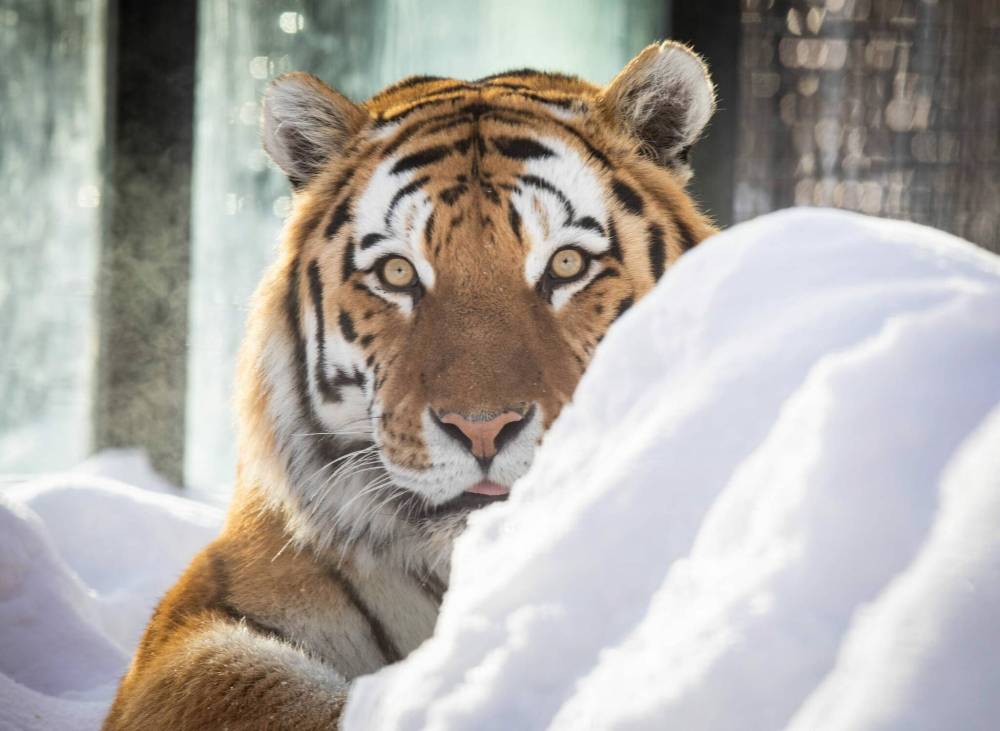
Donnelly’s job requires she get up close and personal — but not too much, there’s a fence between — with all manner of big cats at the zoo, including the tigers, who are always a favourite attraction. For 2022, however, Yuri and Volga are true celebrities. After all, this is their year: today marks the Lunar New Year, which according to the Chinese zodiac is the Year of the Tiger.
In this tradition, the tiger represents ambition, generosity, and courage, along with a certain level of majesty, strength and competitiveness. According to legend, the tiger was one of 12 animals that participated in a race planned by the Jade Emperor; the confident tiger finished third after the cunning rat and the hardworking ox.
Donnelly is no expert on the zodiac, but she knows Yuri and Volga as if they were her own children, and says they each have a distinct personality, just like any other nine-year-old siblings. Yuri only arrived in December, transferred from the Calgary Zoo, but already has shown his true colours. “He’s a pretty big goofball,” she says as Yuri lopes around his habitat. “Whereas his sister is much more sassy.”
Pulling a lever, a door opens and Yuri bolts out to find his breakfast: a major aspect of Donnelly’s job is using “enrichment” techniques to keep the zoo environment fulfilling for the animals living there. One of those strategies is to create food puzzles, mimicking the hunt they’d use to find food in the wild. Yuri’s and Volga’s meals — which include portions of rooster, rabbit, beef, mutton, turkey, and horse — are not served at a routine spot; Donnelly strategically “hides” their meat in new locations each time to maintain variability.
She also uses visual stimuli, physical stimuli, and various scents around the habitat to engage the tiger’s full range of senses and urges to explore. “Today, we used a little bit of Eddie Bauer cologne,” says Donnelly, who also uses natural scents to engage Yuri and Volga. No two days are the same for the cats.
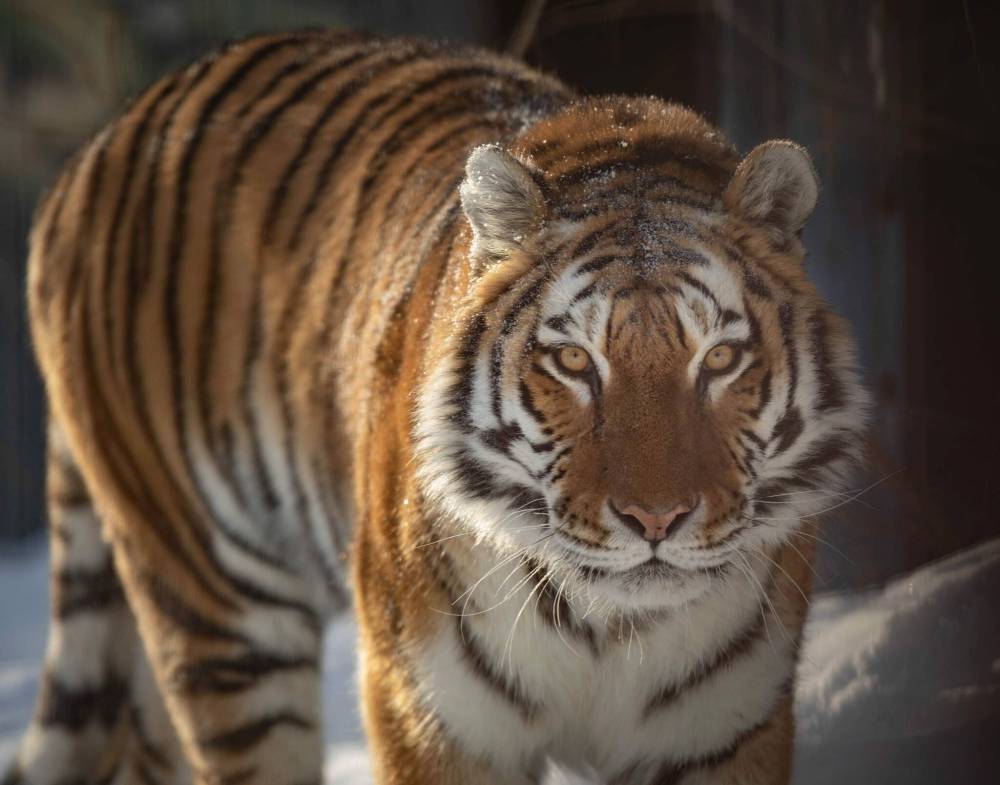
“Variety is the spice of life,” she says, as Yuri plucks his rooster from a cardboard barrel and carries it away to dine out of the public eye.
Amur tigers are solitary creatures, so Yuri and Volga spend their time in separate habitats. Before being released to her outdoor habitat, Volga rests her 120-kilogram body on an elevated platform. She looks just like a house cat, scaled up to gigantic proportions. She purrs, and she chuffs — a form of vocalization big cats use to signal affection.
Volga’s rooster is served on a platform about six feet in the air, and it doesn’t take long for her to find it. With a quiet strength, she leaps to the platform from several feet away, bringing down her meal to eat it al fresco. She takes her time, plucking the feathers off, but like her brother across the way, chewing through and digesting the bones. Volga’s leap is spectacular to onlookers, but routine to Donnelly, who sees the animals in action each day. “They can easily jump on top of an elephant,” she says.
Donnelly has worked at the zoo, mostly with big cats, for more than 10 years. At home, she has a few dogs, plus a cat. “Oddly enough, a big orange tabby.”
She walks around the zoo with at least 10 keys jangling from her waist, each capable of unlocking a new world to creatures most people never get to meet, an all-access pass to zoological secrets. Naturally, she develops a close relationship with the animals, to the point where they feel like members of her family.
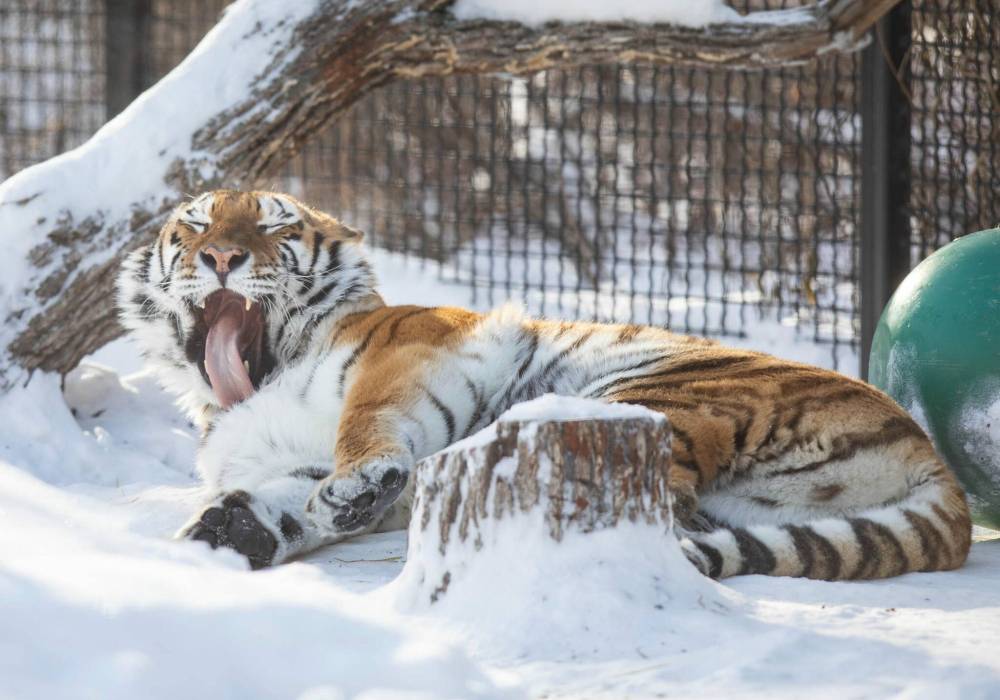
“I’ve raised eight snow leopards,” she says. “Well, their mothers have.”
Donnelly says the Amur tigers are endangered, with fewer than 500 still living in their natural habitats. In the wild, those tigers live between 10 and 15 years; in zoos, they can live as long as 20. Yuri and Volga turn nine in March.
Tigers are victims of misconceptions, Donnelly says: of course, they can be fierce, but they can also exhibit other traits. They can be gentle, quiet, patient, playful, athletic, and intelligent. They can nap for up to 16 hours per day. To many people, tigers such as Yuri and Volga are abstract concepts or the stuff of children’s books more than real creatures. Up close, Donnelly gets to know them as individuals.
“Their personalities are each so special and unique,” she says. “There’s no hiding in how they feel or what they want. They’re very clear and communicative, so long as you’re watching and listening.”
Almost on cue, Volga approaches the fenced barrier to see what’s going on. She stares at Donnelly and begins chuffing, which sounds a little bit like a horse braying, and Donnelly begins feeding her bits of chicken through the fence for dessert.
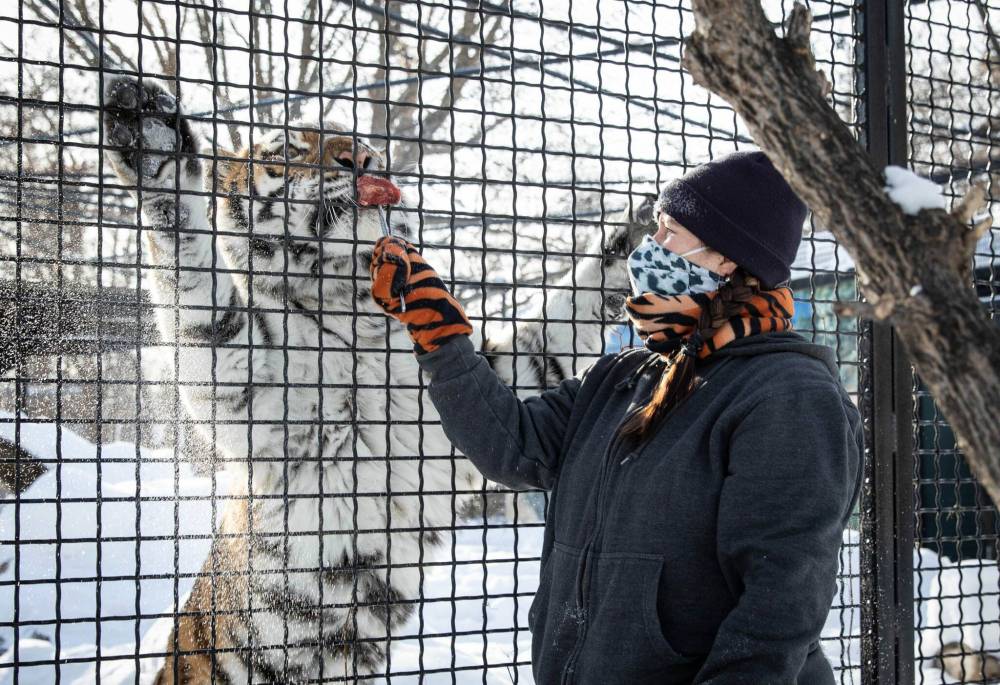
Then, Donnelly walks away to leave Yuri and Volga until their next meeting, a few days before it’s officially their year. “On to the snow leopards,” she says, trudging off.
Ben.waldman@winnipegfreepress.com

Ben Waldman covers a little bit of everything for the Free Press.
Our newsroom depends on a growing audience of readers to power our journalism. If you are not a paid reader, please consider becoming a subscriber.
Our newsroom depends on its audience of readers to power our journalism. Thank you for your support.






